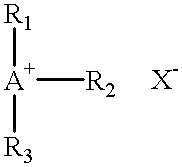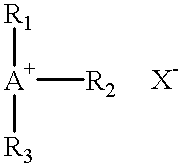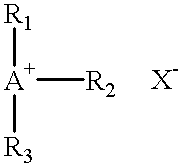In accordance with the invention, an ink-jet printing
system and a set of ink-jet print cartridges are disclosed comprising a a set of ink-jet inks for improved print quality, specifically, reduced bleed; improved edge-acuity, uniform area fills, and
color quality; while maximizing
lightfastness without sacrificing printing reliability. The set of ink-jet inks comprises at least four individual ink where each ink is capable of interacting with the other in order to reduce bleed therebetween.
The use of pigments in the inks provides for prints with excellent
lightfastness. The mutual
reaction scheme between the inks of the ink set enables the production of prints with enhanced print quality, bleed control, sharper line edge-acuity, uniform area fill and good
color quality. Furthermore, inks made according to the present invention are media independent (e.g.,
coated paper, uncoated paper, film) and exhibit reliable printing performance.
The reaction between the black and
magenta inks is caused by the pH difference between the two inks and the
excess hydrogen ions from the magenta ink. The black ink and the yellow ink react by virtue of the opposite charge between the dispersants for the black and the yellow pigments. The black ink and the cyan ink react due to the
precipitation of the dispersed black
pigment by the multi-valent
metal ions (precipitating agent). Additionally, when the fourth ink (e.g., cyan) contains the optional acid, the pH difference between the cyan and the black ink further enhances the
precipitation of the colorant in the black ink.
As used herein, the term "
pigment" refers to a colorant that is insoluble in the aqueous vehicle, and includes disperse dyes. A wide variety of organic and
inorganic pigments, alone or in combination, may be selected to make the ink, examples of which are disclosed in U.S. Pat. No. 5,085,698. The term "
pigment" as used herein means an insoluble colorant. The pigment particles are sufficiently small to permit
free flow of the ink through the ink-jet printing device, especially at the ejecting nozzles that usually have a
diameter ranging from 10 micron to 50 micron. The particle size also has an influence on the
pigment dispersion stability, which is critical throughout the life of the ink.
Brownian motion of minute particles will help prevent the particles from
flocculation. It is also desirable to use
small particles for maximum
color strength and gloss. The range of useful particle size is approximately 0.005 micron to 15 micron. Preferably, the
pigment particle size should range from 0.005 to 5 micron and, next preferably, from 0.005 to 1 micron, and most preferably, from about 0.005 to 0.3 micron.
Precipitating agents are present in the fourth ink. Precipitate formation is facilitated by interaction between the precipitating agent and the carboxyl group of the dispersant in the first ink, and the
sulfonyl and / or phosphonyl group of the dispersant in the second ink. Precipitate formation prevents the migration of the coloring agent from the first and / or the second ink into the adjacent print area produced by the fourth ink. In the preferred embodiment the precipitating agent consists of a multi-valent
metal salt. Exemplary multi-valent
metal cations suitable for use in the multi-valent metal salt include the following-cations listed below in Table 1, below:
In the use of an ink-jet printer, the platen may be at ambient temperature or the platen may be heated. A heated platen in conjunction with a thermal ink-jet printer has been disclosed and claimed in application Ser. No. 07 / 876,942, filed May 1, 1992, and in U.S. Pat. No. 5,479,199, entitled "Print Area
Radiant Heater For Ink-Jet Printer," both assigned to the same assignee as the present application. Heated platens are used to dry the ink faster on the print medium, which may be paper, transparency, or other suitable material.
 Login to View More
Login to View More 


